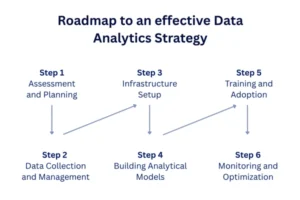Data Analytics is a powerful tool to make any business grow. Be it any industry, the right data use can help your business grow multifold. It is after the use of a data analytics strategy that businesses realize the power of their collected data. Data analytics services can prove more fruitful than one can imagine if only they use the right approach. In this blog, we shall discover what data analytics is, the role of AI in data analysis, and a roadmap data analytics strategy that will certainly improve your business.
What is Data Analysis?
Data Analysis is a process of extracting useful information or deriving insights from raw data. This process includes collecting data, processing and preparing it for the analysis, applying the right approach and tools to derive the desired information, and visualizing it for a clear understanding. There are various approaches to perform data analysis, and there are many types as well. The basic types of data analysis are divided into two types: 1) Qualitative Analysis and 2) Quantitative Analysis. We will look into the process of data analysis strategy after understanding how AI can play a role in data analysis.
What is AI and How Does It Impact Data Analysis?
AI (artificial intelligence) is a technology that has taken the world by storm. AI leverages various other technologies, such as machine learning solutions, natural language processing, and neural networks, to perform tasks that previously required human intelligence. What does AI work on? It’s data. AI is trained on a large amount of data to understand and mimic human brain functioning, but faster. Now, with the power of predictive AI and natural language processing, the data analysis process can be AI-powered for efficient, speedy, and more accurate analysis. It is because the human brain and traditional tools could only handle a certain amount of data, while AI can process large amounts of data, find hidden patterns, visualize results better, and provide actionable plans or corrective measures based on the results.
Benefits of Data Analytics Strategy for Business
A well-planned data analytics strategy can help businesses optimize operations, encourage innovation, and increase profits. Here, we shall see some important benefits of a data analytics strategy for businesses.
-
Data-Driven Decision-Making
Data Analysis allows business owners and stakeholders to understand the state of their business in the market. It provides a proper report of all the data and thus makes more informed decisions. Data-driven decisions are more practical and effective for business growth and development.
-
Operational Efficiency
Data analysis can help identify lags and inefficiencies in processes and can also suggest improvements. This leads to streamlined operations. Such optimized operations are low in cost and boost productivity.
-
Competitive advantage
Data analysis not only analyzes organizational data, but also observes and compares your business state with market conditions. This helps businesses stay competitive with other businesses in the industry. Data analysis studies customer behavior and the market trends to keep your business up-to-date.
-
Risk Mitigation
Predictive analysis can anticipate and handle risks in real-time. It understands normalcy through training data and warns when it detects any abnormal behavior. It thus allows businesses to take proactive steps and minimize the impact.
-
Innovation
Artificial intelligence and machine learning provide new ideas according to customer demands in the market. This allows businesses to keep innovating frequently. Generative AI technology even creates designs and multiple versions of a design for custom products and innovation.
Roadmap to Data Analytics Strategy
To create an effective and tailor-made data analytics strategy, businesses need to follow a step-by-step roadmap. You can also connect to some analytics service provider for the same. Here are some major steps you need to follow for a practical and impactful data analytics strategy.

Make a Data Analytics and AI Strategy Vision
The first and foremost step in any changes for business growth is to establish a clear vision and a strategy that matches your goals. Also, it is necessary that your stakeholders agree with your vision and strategy. So, understand the priorities of your business and how a data analytics and AI strategy can help achieve that. Optimize your strategy to align with your goals and budget after calculating risks, opportunities, and return on investment.
Create an Operating Model
The next step, once you have a clear vision in mind, is to create a model that supports data literacy, AI preparedness, and business value. Build advanced analytics capabilities in the organization, ensure data literacy across teams, and leverage machine learning solutions to drive business value. This step includes ensuring regulatory compliance.
Culture and Governance
This step is about preparing your organization and stakeholders for the upcoming changes. Train and establish the value of data analytics and AI strategy to everyone in the organization. Also, assign governance roles in the team for ethical and responsible use of AI and data analytics tools.
Value Management
In this phase of your data analytics strategy roadmap, you need to demonstrate the value of data and AI investment and link them to direct business results. Integrate your data analytics and AI with other enterprise-wide platforms to avoid data silos. Create an investment portfolio and monitor the value delivered. This step helps understand the value your project delivers after implementation.
Iterate and Progress
The last step is to improve continuously. Make sure that your strategy is adaptable and adjusts to deliver desired results with new tools and capabilities added. Track your program and refine it with feedback. Update your strategy with emerging technologies, and upskill to manage an evolving strategy.
Best Practices for Adopting an Effective Data Analytics Strategy
To harness the potential of your collected data to the fullest, you should opt for an optimized and effective data analytics strategy. To build such a strategy, you need to follow a roadmap and some best practices. These best practices are mentioned here for your consideration.
- Start Small and Scale Fast
- Cross-Department Collaboration
- Data Democratization
- Regular Review and Adaptation
Common Mistakes To Avoid
Even after building a foolproof data analytics and AI strategy, organizations end up making some mistakes that impact their project. Let us see those common mistakes that we need to avoid for actually building an effective data analysis strategy.
- Lack of Clear Objectives
- Underestimating Data Quality
- Ignoring Change Management
- Overloading the Strategy
- Lack of Skilled Professionals
- Poor Data Governance
- Focusing on Technology over Requirements
- Failure to Improve and Adapt
How Can We Help?
AnavClouds Analytics.ai is an AI development company with expert data scientists and AI experts teaming up to provide robust business solutions. Whether your business needs restructuring with CRM systems, AI-powered machine learning solutions, or data analytics services, we provide it all. With years of experience and the trust that our clients put in our services, we ensure that your business solutions are tailored to meet your requirements. You can simply connect with us for a detailed consultation regarding your business issues, and we will create the best-suited solution for it.
Conclusion
The surging demand for data analytics and AI strategies for business growth is evidence of the massive impact it can create on your business. Even though the process sounds complex and time-consuming, AI-powered data analytics can do it in the blink of an eye. With skilled professionals on your side, you can rest assured that your investment is going to provide you good ROI. Book a demo with us soon and discover the potential of your future-ready business.
FAQs
What are the 5 Cs of Data Analysis?
The 5 Cs of data analysis are Consent, Clarity, Consistency, Control, and Consequences.
What are the five pillars of data strategy?
The five pillars of an effective modern data strategy are Data architecture, Data governance, Analytics techniques, Collaboration, and Data culture.
What is a data analytics strategy?
A data analytics strategy is a step-by-step roadmap of data analysis adoption in an organization or business, with clear consideration of business goals, investments, limitations, and expected ROI.
What are the key elements of a data strategy?
The key elements of a data strategy are identification, storage, provision, integration, and governance.
What are the 7 golden rules of data?
The 7 rules of data mean factors to be considered while collecting and preparing data; these rules are Necessary, Proportionate, Adequate, Timely, Secure, Relevant, and Accurate data.



